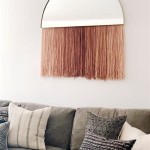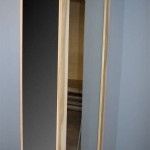How High to Hang a Mirror Above Furniture
Hanging a mirror above furniture, such as a console table, a dresser, or a fireplace mantel, is a common design technique used to enhance the aesthetics and functionality of a space. Proper placement is crucial to achieving the desired visual impact and creating a balanced, harmonious environment. Determining the ideal height involves several factors, including the size of the mirror, the dimensions of the furniture, the ceiling height, and the overall style of the room. This article provides comprehensive guidance on how to strategically position a mirror above furniture to maximize its visual appeal and practical benefits.
Understanding the Importance of Proportion and Balance
Proportion and balance are fundamental principles of interior design, and they play a significant role in determining the optimal height for a mirror above furniture. A well-proportioned arrangement ensures that the mirror complements the furniture and the surrounding space, creating a visually pleasing composition. Conversely, a poorly positioned mirror can disrupt the balance of the room, leading to an awkward and disjointed appearance.
When considering proportion, it is essential to examine the relationship between the size of the mirror and the dimensions of the furniture. A general guideline is to select a mirror that is approximately two-thirds to three-quarters the width of the furniture. This ratio typically creates a balanced visual effect. For example, if a console table is 48 inches wide, the ideal mirror width would fall between 32 and 36 inches. While these figures serve as starting points, they are guidelines, and individual preferences and the specific characteristics of the room may necessitate adjustments.
The height of the mirror is equally important. The goal is to position the mirror in a way that it feels connected to the furniture beneath it, rather than floating independently on the wall. A common mistake is to hang the mirror too high, which can create a disconnected and unbalanced look. To achieve balance, the distance between the top of the furniture and the bottom of the mirror should be carefully considered. A general recommendation is to maintain a space of 5 to 10 inches, or approximately 12 to 25 centimeters, between the furniture and the mirror. This spacing allows the mirror to visually anchor the furniture and create a cohesive unit.
The ceiling height also influences the perception of the space and the placement of the mirror. In rooms with high ceilings, greater vertical space can be utilized without creating a sense of imbalance. Mirrors can be hung slightly higher in these rooms to draw the eye upward and accentuate the vertical dimension. Conversely, in rooms with low ceilings, it is generally preferable to keep the mirror closer to the furniture to avoid overwhelming the space. An overly large mirror hung too high in a low-ceilinged room can make the room feel even smaller and more cramped. Therefore, scale and proportion must be carefully considered within the overall architectural context of the room.
Furthermore, the style of the furniture and the mirror should also be taken into account. A modern, minimalist arrangement may call for a different placement than a traditional, ornate setting. Modern designs often feature clean lines and geometric shapes, and the mirror placement may reflect this aesthetic with a more streamlined and understated approach. Traditional designs, on the other hand, may incorporate more elaborate frames and decorative elements, which may influence the positioning of the mirror to highlight these features.
Accounting for Eye Level and Viewing Angles
Eye level is a critical factor when determining the optimal height for hanging a mirror. The goal is to position the mirror so that it reflects the space at an appropriate viewing angle, allowing individuals to easily see their reflection and appreciate the surrounding environment. This consideration is particularly important in areas where the mirror serves a functional purpose, such as in a dressing area or near an entryway.
The average eye level for adults is typically between 5’4” and 5’6” (64 to 66 inches, or 162 to 168 centimeters). Ideally, the center of the mirror should be positioned at or slightly above this height. This placement ensures that most individuals can comfortably see their reflection without having to strain their neck or bend down. However, this is just a general guideline, and the specific needs and preferences of the occupants should be taken into account.
In households with taller individuals, it may be necessary to adjust the height of the mirror accordingly. Similarly, in areas where children frequently use the mirror, it may be beneficial to consider their eye level as well. A potential solution for accommodating different heights is to opt for a larger mirror that extends both above and below the average eye level, ensuring that everyone can benefit from its reflective properties.
The viewing angle also plays a significant role. When hanging a mirror above furniture, it is important to consider what the mirror will be reflecting. In many cases, the objective is to reflect light and expand the perceived space of the room. Positioning the mirror to reflect a window or a light source can significantly brighten the room and create a more open and airy atmosphere. However, it is also important to avoid reflecting undesirable views, such as a cluttered corner or an unattractive wall. Careful consideration of the viewing angle can help to maximize the benefits of the mirror and enhance the overall aesthetic appeal of the room.
Furthermore, the distance from which the mirror will be viewed should also be considered. In smaller rooms, a mirror may be viewed from a closer distance, requiring a slightly lower placement to ensure comfortable viewing. In larger rooms, the mirror may be viewed from a greater distance, allowing for a slightly higher placement. Experimenting with different viewing angles and distances can help to determine the optimal placement for the mirror in a specific space.
Finally, the intended purpose of the mirror should also be taken into account. If the mirror is primarily intended for decorative purposes, the placement may be less constrained by functional considerations. However, if the mirror is intended for practical use, such as checking one's appearance, the placement should prioritize usability and accessibility.
Considering the Function and Style of the Space
Beyond proportion and eye level, the function and style of the space are also important considerations when determining the optimal height for hanging a mirror above furniture. The placement of the mirror should complement the overall design scheme and enhance the intended purpose of the room.
In formal living rooms or dining rooms, a mirror above a console table or fireplace mantel can serve as a focal point, adding elegance and sophistication to the space. In these settings, the mirror may be hung slightly higher to draw the eye upward and create a grander impression. The frame of the mirror can also play a significant role in enhancing the aesthetic appeal, with ornate frames adding a touch of luxury and simpler frames providing a more understated elegance.
In bedrooms or dressing areas, a mirror above a dresser serves a more practical purpose, providing a convenient place to check one's appearance. In these settings, the placement of the mirror should prioritize usability and accessibility. The mirror should be positioned at a height that allows for comfortable viewing, and it should be large enough to provide a full reflection. The style of the mirror should also complement the overall design of the bedroom, with options ranging from sleek, modern designs to more traditional, ornate styles.
In entryways, a mirror above a console table can serve both a decorative and functional purpose. It can provide a convenient place to check one's appearance before leaving the house, and it can also help to brighten the space and create a more welcoming atmosphere. The placement of the mirror should be carefully considered to ensure that it reflects light and creates a sense of openness. A well-placed mirror in an entryway can make a small space feel larger and more inviting.
The style of the room should also influence the choice of mirror and its placement. In modern, minimalist spaces, a simple, frameless mirror may be the best choice. The placement of the mirror should be clean and uncluttered, with a focus on functionality and simplicity. In more traditional spaces, a mirror with a decorative frame may be more appropriate. The placement of the mirror can be more elaborate, with a focus on creating a sense of elegance and sophistication.
Ultimately, the optimal height for hanging a mirror above furniture is a matter of personal preference and depends on the specific characteristics of the space. By carefully considering the factors outlined in this article – proportion, eye level, function, and style – individuals can make informed decisions and create a visually pleasing and functional arrangement.

Tips On How High To Hang A Mirror For Your Space I Shutterfly

Tips On How High To Hang A Mirror For Your Space I Shutterfly

Tips On How High To Hang A Mirror Interior Design Blog Hadley Court

How High To Hang A Mirror Above Console Table

How High To Hang Mirror Over Sofa Life

Tips On Hanging A Mirror Over Furniture C Home Limited

Tips On How High To Hang A Mirror Interior Design Blog Hadley Court

Tips On How High To Hang A Mirror Interior Design Blog Hadley Court

Console Tables And Round Mirrors A Perfect Combination

Do S And Don Ts For Hanging Your Mirrors Artwork The Seattle Times








